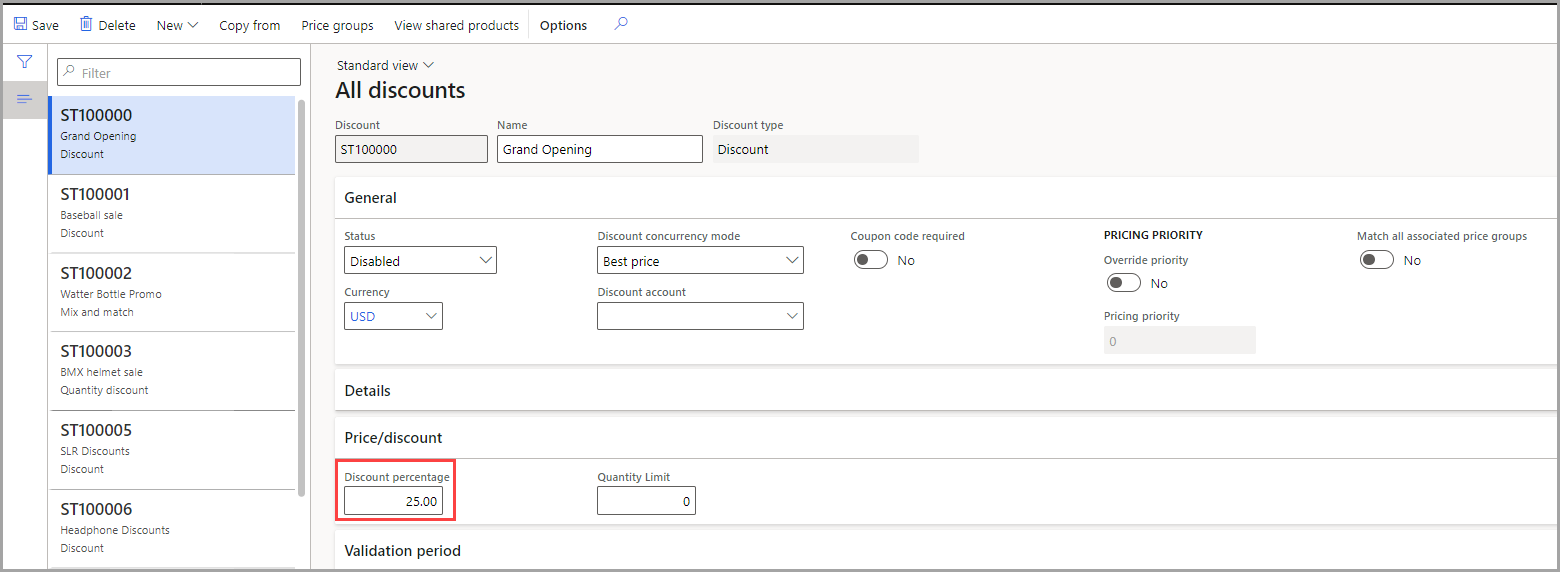Retail discount types
Five pricing components use the discounts functionality, but only four of them are discounts. Price adjustments are part of the selling price strategy, so it not considered a true discount. The other four pricing components are true discounts that are applied to the selling price:
- Simple – A single percentage or amount. (For example: Get five percent off any item in a category this weekend only.)
- Quantity – A discount that is applied when two or more products are purchased. (For example: Buy three or more and get 20 percent off.)
- Mix and match – A discount that is applied when a specific combination of products is purchased. (For example: Buy five products of a specific type and get 5 percent off all.)
- Threshold – A discount that is applied when the transaction total is more than a specified amount. (For example: Buy 100 US dollars (USD) or more and get USD 5.00 off.) Sometimes retailers want the threshold discount to compete with other discounts to apply the best discount. Retailers can turn on a configuration that will ensure the exclusive threshold discounts compete with the other exclusive non-threshold discounts to offer the best price.
Objects that use the discount functionality can be applied to products, variants, or categories, and they use the price groups that will be assigned to the correct entities. Through the advanced discount periods functionality, the configurations support several date and time formats.
Discounts can be applied by a discount percentage, cash discount amount, or discount price for entire categories or lines, with the option to specify if the line should be excluded or included when sales associates are applying the discount (for example, all items in a category except for one item).
Commerce discounts can be viewed and created in Retail and Commerce > Pricing and discounts > All discounts. From here, you can specify a field such as Discount percentage, apply any other rules you would like to be activated, and save the discount.
Discounts can be enabled or disabled. If they are disabled, they can be edited but won't be used in the pricing engine. If they’re enabled, the pricing engine will evaluate them when determining discounts.
The pricing engine also determines what discounts are to be applied to both an individual sales line and a customer’s entire cart. Because there may be multiple or varying discounts that apply to a larger order, Commerce can intuitively check the entire cart to see what discount to apply.
Also, because it is common for B2B companies and even some B2C companies to have large order sizes, discount calculation can be delayed to improve sales order performance by enabling the Manually calculate multi-line prices and discounts field in Commerce parameters > Prices and discounts. With this field enabled, the pricing engine will only look at the sales line that is being added or edited to avoid slowing down the entire sales order process.
Other discounts
Several other discounts can be applied to orders that exist outside of the standard discounting examples that were previously explained:
- Coupons - Discounts that require codes or a barcode to add a specific discount to a transaction. Coupons can restrict the use by date and require a customer, or they can set a maximum number of redeemable coupons before expiring. Coupons are placed on top of discounts and require the discount to have the Coupon code required option enabled.
- Tender-based – Line-based percentage discounts that are granted at time of payment, based on a tender type that a company wants to promote. It is added to existing discounts, regardless of restrictions.
- Shipping – Discount or offer of free shipping for specific shipping methods for an order, if certain criteria are met. (For example: Spend more than 100 USD on the transaction and get free shipping.)
Watch the following video for an overview of retail discount types and of how to use the price simulator (which will be discussed later in this module).
